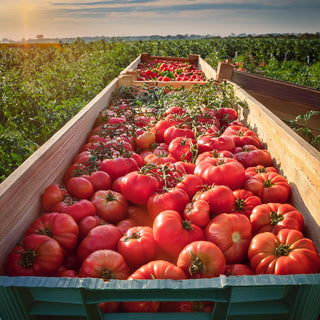Quick snapshot
-
What it is: A fragrant, anise‑like herb prized in classic European cookery and beyond.
-
Main types: French tarragon (Artemisia dracunculus var. sativa), Russian tarragon (A. dracunculus), and Mexican tarragon (Tagetes lucida).
-
Headline flavour: Sweet anise, with peppery, slightly bittersweet undertones (strongest in French tarragon).
-
Most used globally: French tarragon in Europe and Western kitchens; Mexican tarragon in Mexico/Central America and hot climates; Russian tarragon across parts of Eastern Europe/Caucasus for drinks and pickles.
Origins & a bite of history
Tarragon likely originated across Central Asia/Siberia and spread westward with trade and migration. Its name traces through Persian (tarkhūn) and Arabic into medieval European languages. By the Middle Ages it had become embedded in European herbals and monastery gardens. In France it rose to culinary stardom—think tarragon vinegar, Béarnaise sauce, fines herbes, and classic roast chicken with tarragon.
The three tarragons (and how to tell them apart)
1) French tarragon (Artemisia dracunculus var. sativa)
-
Flavour: The gold standard—clean, sweet anise/licorice with a gentle peppery finish.
-
Growth: A sterile cultivar; does not grow true from seed. Propagate by division or cuttings.
-
Habit: Herbaceous perennial; dies back in cold winters and re‑shoots in spring.
-
Best for: Sauces (Béarnaise, pan sauces), poultry, fish, eggs, salad dressings, compound butters.
2) Russian tarragon (Artemisia dracunculus)
-
Flavour: Milder, often grassy; can be coarse if grown hard. Sometimes develops more aroma in poor, dry soils.
-
Growth: Seed‑grown, hardy, vigorous, and easy to establish.
-
Best for: Infusions (vinegars, syrups), pickles, herbal teas, and as a hardy garden stand‑in where French tarragon struggles.
3) Mexican tarragon (Tagetes lucida) — aka Texas tarragon, Mexican mint marigold
-
Flavour: Strong anise with a sweet, floral note—excellent culinary substitute when heat or humidity knock French tarragon around.
-
Growth: Heat‑loving, drought‑tolerant perennial (botanically a marigold). Produces cheerful yellow blooms that also attract pollinators.
-
Best for: Salsas and stews in Mexican/Central American cooking, and as a French‑style tarragon substitute in warm climates.
What the world actually uses
-
France & Western Europe: French tarragon reigns. Key roles in fines herbes (with chives, chervil, parsley), tarragon vinegar, Béarnaise, chicken à l’estragon, and delicate egg/fish dishes.
-
Eastern Europe & the Caucasus: Russian tarragon features in pickles and herbal drinks; it flavours the bright green soft drink “Tarhun/Tarkhuna” in Georgia/Armenia.
-
Mexico & Central America: Mexican tarragon (yauhtli) used traditionally for teas, stews, moles, and as a warm‑climate stand‑in for French tarragon.
-
Iran & the Middle East: Tarragon appears in fresh herb platters (sabzi khordan), salads, and pickles.
-
Australia (practical view): Chefs prefer French tarragon for precision sauces; home growers in hotter regions lean on Mexican tarragon for reliability. In cooler southern gardens (VIC/SA/TAS), French tarragon thrives with winter dormancy; in warmer states, give it afternoon shade or grow Mexican tarragon instead.
Buying forms & pantry staples
-
Fresh sprigs: Bright green, soft leaves; best aroma. Add late in cooking.
-
Dried leaves: Convenient but less aromatic; use ~1/3 the fresh volume as a starting point and adjust.
-
Infusions: Tarragon vinegar, tarragon mustard, and tarragon oil deliver quick flavour to dressings and pan sauces.
How to grow tarragon (Australia‑friendly)
Position: Morning sun and light afternoon shade in hot summers; free‑draining soil.
Watering: Keep evenly moist but never boggy. Slightly drier soil intensifies flavour (especially for Russian tarragon).
Feeding: Light, regular feeds; avoid heavy nitrogen, which dilutes flavour oils.
Propagation:
-
French tarragon — division in late winter/early spring; softwood cuttings in spring.
-
Russian tarragon — sow seed in spring.
-
Mexican tarragon — strike cuttings easily; divide clumps.
Containers: Excellent in pots (20–30 cm+). Refresh potting mix each spring.
Seasonality: French tarragon goes dormant in winter in cool zones; cut back and mulch. Mexican tarragon stays showy longer in warmth.
Pests/disease: Generally low‑pressure; watch for root rot in wet soils and the odd aphid/whitefly; use integrated pest management (beneficials, gentle soaps) first.
Flavour science (why they taste different)
-
French tarragon: Rich in estragole (methyl chavicol) → clean anise aroma.
-
Mexican tarragon: Also anise‑leaning (estragole/anethole) with a floral marigold edge.
-
Russian tarragon: Lower aromatic oil content overall → milder, grassy.
Kitchen playbook: easy ways to use tarragon
-
Five‑minute dressing: 1 part tarragon vinegar, 3 parts olive oil, pinch of Dijon, chopped fresh tarragon, salt/pepper.
-
Weeknight pan sauce: Deglaze roast chicken pan with white wine; add stock, a knob of butter, cream, and chopped tarragon.
-
Eggs elevated: Fold fresh tarragon into omelettes, quiches, or scrambled eggs.
-
Seafood & veg: Pairs beautifully with salmon, scallops, zucchini, asparagus, and potatoes.
-
Herb butter: Mash softened butter with tarragon, lemon zest, and a little garlic; freeze in discs for steaks or vegetables.
FAQs
Is French tarragon worth chasing over Russian? If you’re cooking classic European dishes, yes—the flavour is cleaner and more potent. For tougher climates or low‑maintenance patches, Russian or Mexican tarragon will earn their space.
Why won’t my French tarragon grow from seed? It’s sterile. Buy plants, or take divisions/cuttings.
Can I substitute one type for another? Often, yes. Use Mexican tarragon 1:1 for French in cooked dishes; in delicate, raw applications (e.g., fines herbes) French is best.
Bottom line
-
Most used around the world: French tarragon (European/classic cooking), Mexican tarragon (Mexico/Central America and hot climates), Russian tarragon (Eastern Europe/Caucasus, hardy gardens).
-
For growers: Choose the species that fits your climate—and remember French tarragon must be propagated vegetatively for true flavour.
For cooks: Add it late, keep it gentle, and let that sweet anise lift your dish rather than dominate it.
In my opinion:
1. French (Hard to find)
2. Mexican (most uses around Australian dishes and sold as French is most cases)
3. Russian (ok, but avoid if you can)






